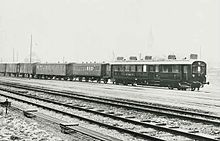BT BCFm 2/4
| BCFm 2/4 | |
|---|---|
| Numbering: | 31-32 |
| Manufacturer: | SLM , SIG |
| Year of construction (s): | 1926-1927 |
| Retirement: | 1932 |
| Empty mass: | approx. 36 t |
| Installed capacity: | 132 kW (180 PS ) |
| Power transmission: | mechanically |
| Seats: | 16 (2nd class) 50 (3rd class) |
The BCFm 2/4 of the Bodensee-Toggenburg-Bahn (BT) were two four-axle railcars with gasoline engines .
history
In the 1920s, various railways tried to rationalize their operations with railcars . In December 1925, BT used a German gasoline railcar on a trial basis. In contrast to a steam locomotive , such a vehicle could be operated by a single man.
The attempt was satisfactory and there was an offer of CHF 300,000 for two railcars from the Swiss Lokomotiv- und Maschinenfabrik (SLM) and the Swiss Industrial Company (SIG) . On April 3, 1926, the BT board of directors ordered two so-called petrol motor vehicles , the car bodies of which were built by SIG in Neuhausen. The chassis and engines came from SLM in Winterthur. In 1929 the neighboring narrow-gauge Appenzeller Bahn received similar BCFm 2/4 .
Technical
The railcar had two bogies, with the outer axle as a running axle and the inner as a driving axle (1A) (A1). They had a four-stage mechanical transmission from the SLM.
The vehicles were given a second and third class passenger compartment, a toilet, a luggage compartment and two driver's cabs . They looked very peculiar with their roof structures for the engine cooling. With their modest output of 180 hp , they were not suitable for pulling multiple cars. They were therefore designed more as a single driver, but had normal pulling and pushing devices.
The SLM serial numbers are 3184 and 3185.
commitment
The two railcars made it possible to condense the timetable between St. Gallen and Herisau . In times of low traffic, they were used between Wattwil and Nesslau-Neu St. Johann and in natural compensation on neighboring SBB routes.
In 1929, the two railcars covered 132,793 kilometers, which was around a quarter of the total mileage of all BT railcars that year. Of these, 85,511 on BT tracks and 47,282 as compensation in kind on SBB tracks.
The electrification made the two railcars in 1932 superfluous. The engine and drive were removed and the vehicles continued to be used as the BCF4 passenger car . In 1954 there was a further conversion to BC 4ü and C 4ü, from June 3, 1956 their names were AB 4ü 128 and B 4ü 328.
literature
- Gerhard Oswald: The Bodensee-Toggenburg Railway . Appenzeller Verlag, Herisau 2004, ISBN 978-3-85882-361-8 . Pages 130-131
Individual evidence
- ↑ Swiss Locomotive Construction 1871–1971, page 127
- ↑ SLM locomotives 1871-1984 page 86
- ↑ Fifty years of the Bodensee-Toggenburg Railway, page 137
- ↑ Fifty Years of the Bodensee-Toggenburg Railway, page 138
- ↑ Fifty years of the Bodensee-Toggenburg Railway, page 387
Remarks
- ↑ In the advertisement of April 29, 1930 in the Bauzeitung Volume 95, Issue 17, there is an indication of 200 hp
Web links
Advertisement of the SLM in the Swiss construction newspaper, Volume 95 (1930), Issue 17 (E-Periodica)

